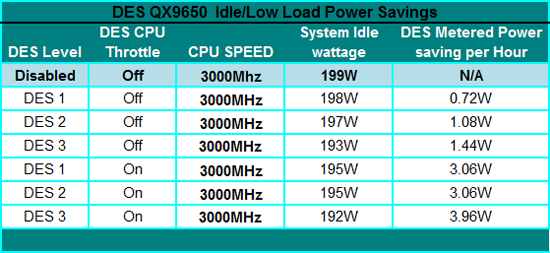Gigabyte goes "Green" with DES software
by Rajinder Gill on January 23, 2008 10:00 AM EST- Posted in
- Motherboards
Test Results
 |
We used four instances of Folding@Home to load each CPU core individually. The DES power savings column shows that savings of 7W per hour is possible if the CPU is loaded 100%. Around 20,000 users worldwide currently participate in the Stanford Folding@Home program, which is used to help protein related disease research. Many of the participants run quad-core processors at a 100% load, almost 365 days a year. Based upon current 1kWH unit pricing in the US, a DES setting of 3 would equate to an approximate $6.63 dollar saving over the course of one year - if the processor retains a 100% load throughout this time.
Okay, these numbers are not exactly substantial, but they are better than no savings at all. To an individual, the power savings shown here may seem miniscule. The broader picture is that the DES software will be available on most of Gigabyte recent boards. It's just a matter of how many people decide to put the software to use. As with most forms of power economy, it takes a global effort to instigate meaningful power consumption reductions. A further look into why the power savings are minimal with our setup is that Intel's QX9650 - and their 45nm processors in general - are very power economical by design, especially at stock settings. Again, the Hafnium based 45nm technology shows the virtues of incredibly low power leakage at stock speeds. That is why the difference in wall power draw is so small, even when reducing Vcore at stock speeds.
 |
For word processing or web browsing, there is absolutely no harm in using DES level 3 with CPU throttling enabled. An approximate saving of almost 4W per hour is possible; again, this is not massive but every bit of savings is still worthwhile in the grand scheme of things.
 |
In this test we decided to manipulate Vcore levels manually to DES levels without using DES. We also took this a step further (the bottom row in the table) and reduced Vcore to the lowest level that we could run our QX9650 at 3GHz stable. The 45nm process allows these processors to run incredibly low levels of Vcore at 3GHz. What has become clear at this point is that switching off some of the phases does not really benefit the user by reducing system power consumption from the wall. Further, as there is no user VCore control in DES, manual Vcore tuning to lower values than DES level 3 brings the prospect of increased overall power savings.
It is important to note that Gigabyte's Easy tune 5 software allows manual Vcore adjustment within the OS. Okay, so it's not quite as easy as the 1-click feature of DES, but Easy Tune 5 is almost as easy to use for manual Vcore adjustment (two clicks to be precise). The only rub here is that it does take a little bit of time running stability software to work out just how low you can take the Vcore whilst retaining system stability. Of course, the QX9650 is currently the best processor that money can buy and represents top speed binned silicon. The lower binned processors should still allow users to undervolt the Vcore quite effectively, obviously at the cost of a lower overall CPU speed.










16 Comments
View All Comments
icthy - Wednesday, January 23, 2008 - link
Is this software tied to a specific OS, like Vista?Rajinder Gill - Wednesday, January 23, 2008 - link
DES works with both XP and Vista (32 and 64bit)...regards
Raja
legoman666 - Wednesday, January 23, 2008 - link
the power savings seem too low to be of any real value. Just turn off the light while you're gaming or something.androo - Wednesday, January 23, 2008 - link
It's an interesting concept, but the test rig is not what I would pick if I was worried about power. Water cooling? 8800GTS? 1000W Power Supply? Sounds more like my gaming rig which is only on when I play. Best way to save power on a behemoth system is to turn it off.If you are worried about power, select an appropriate video card, the 8300GS at 24 watts or the HD2400Pro at 10 watts for example. A quality active PFC 350 Watt power supply and 1 or 2 fans for cooling. A nice, quiet low power system. It's no gaming rig, but who needs a gaming rig for email, web, movies, coding, etc ... the stuff we do all day.
Chadder007 - Wednesday, January 23, 2008 - link
""Stable power draw is in the region of 2200W when both units have reached cooling capacity. In case anyone is wondering just how much power it takes to send a watt-meter off the scale, it's around 3588W.""3588 watts? WTF?
Rajinder Gill - Wednesday, January 23, 2008 - link
Yes my friend, over 3588W switch on surge, the watt-meter 'flat-lines' when I switch both cascades on together. Of course the meter may just be inaccurate when up that high.(UK 220 13 amp sustained max). It can handle short peaks or surges over that... The bigger unit has 2 X 1.5HP rotary compressors, the smaller unit 1HP + 1/3HP.. Naturally I plug the rest of the system to a separate ring while benching..Lol
regards
Raja